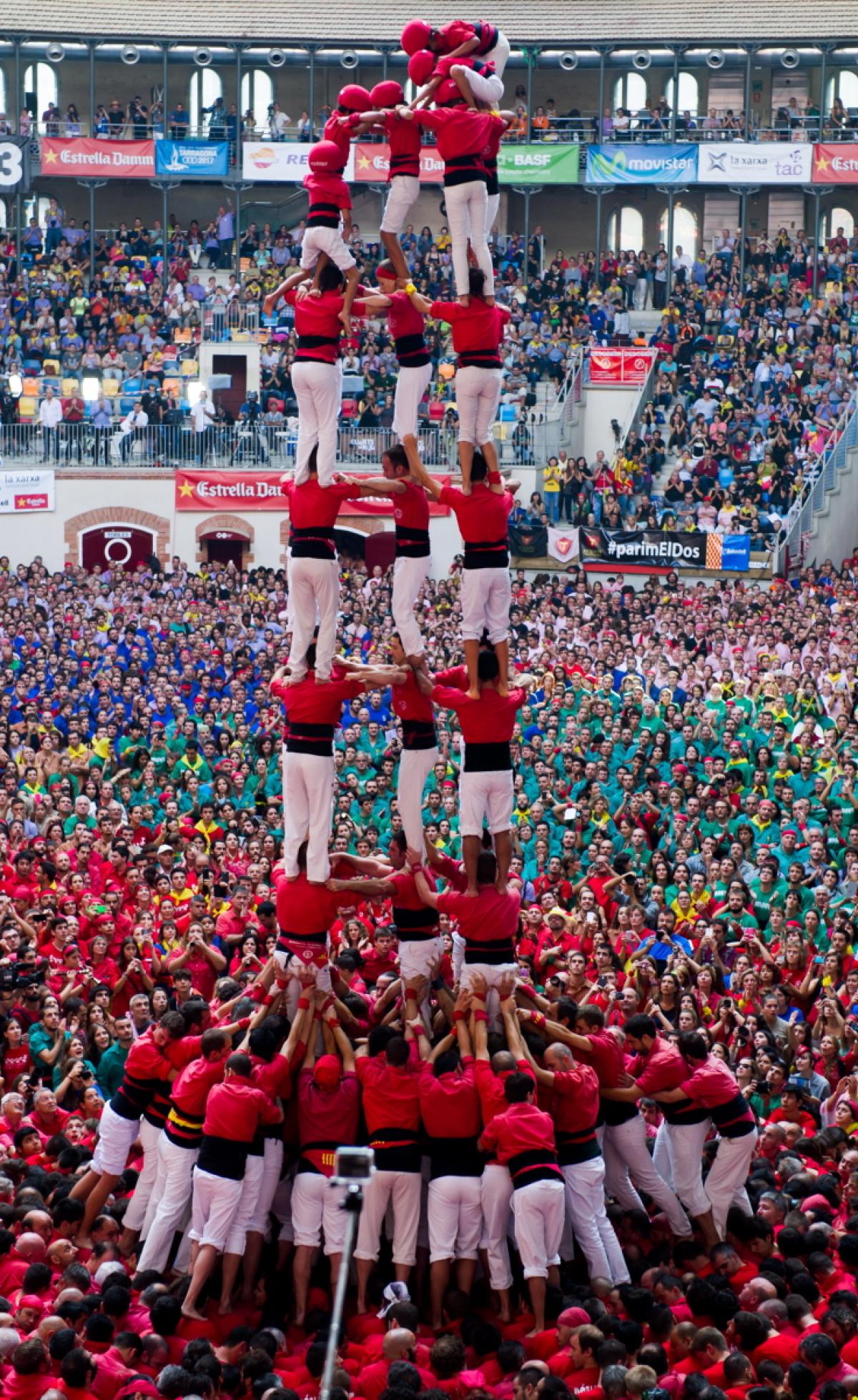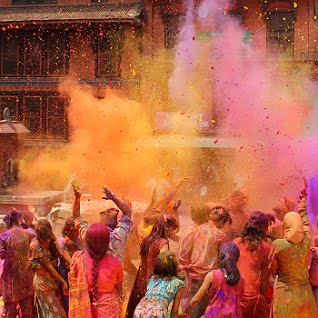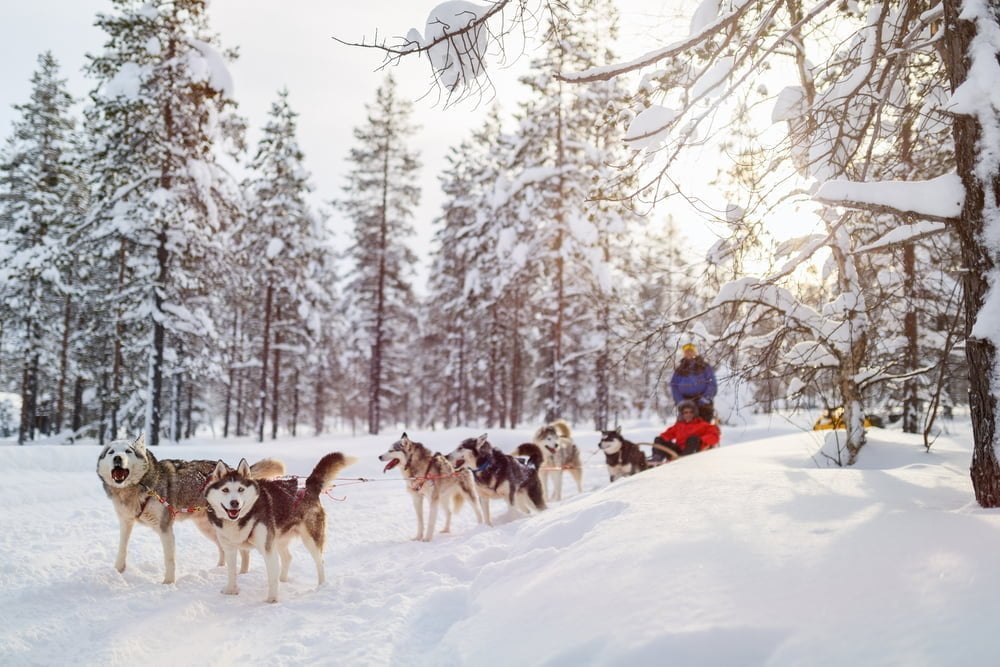Festivals around the world
The theme of our 2020 calendars this year is Festivals around the world. The whole team has chipped in with their favourite festivals and we’ve shortlisted 1 per month. We hope you enjoy reading about them.
January
International Ice and Snow Sculpture Festival – Harbin, China
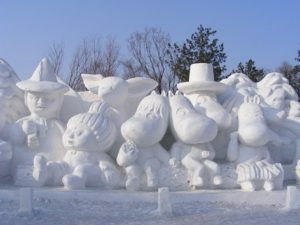
The international Ice and Snow Sculpture festival in China attracts an astonishing 10-15 million visitors every year. It is a spectacle for the whole family! The festival first started in 1963 and opens its gates from mid-end December until the end of February. The 2020 festival starts between the 20th and 25th December 2019. See the full programme here
There are 3 main venues to visit at the festival:
Sun Island Park
In downtown Harbin, Sun Island Park has huge flurries of snow, which is all carved into magnificent snow sculptures. There’s an international snow sculpture competition, which is in its 25th year and will run from 4th-6th January 2020. The park is only open to visitors during the daytime, so we recommend visiting this one early on in the day.
Ice and Snow World
Ice and Snow World is one of the biggest winter theme park attractions in the world. It’s a mini city filled with huge scale ice sculptures like palaces and castles, which are all lit up with LED lighting. There’s a giant amusement park and areas to do all sorts of activities such as snowmobiling, ice rock climbing and ski skating. Get there around 2pm to have a go at some of the exciting activities and then walk around as the sun sets and view the amazing lit-up sculptures!
Zhaolin Park
Zhaolin Park is for families with children and is home to an array of snow and ice sculptures. You can find all kinds of well-known characters and animals like the amazing Moomins in our calendar. It’s also home to the Harbin Ice Lantern Art Fair and the ice lanterns light up all of the sculptures.
If you’re booking a last-minute trip take a lot of thermal layers as the average temperate is -13°C!
February
Venice Carnival – Italy
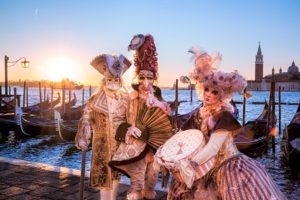
Venice Carnival, which will take place between the 8th and 25th February in 2020, has been held on and off in St Mark’s Square since 1162. Now attracting 3 million visitors, the floating city’s narrow streets are filled with thousands of people wearing incredible, traditional Venetian costumes and masks that have taken weeks or months to design and create. It’s an amazing opportunity to experience how life in Venice was hundreds of years ago.
Some of the main highlights include:
Water parade
At 11am on the first Sunday of the carnival, which is Sunday 9th February this year, the famous water parade takes place. Hundreds of colourful, decorated boats sail along the Grand Canal from the Punta della Dogana art museum and onto the Cannaregio canal. There is a theme each year and in 2019 the theme was Tutta colpa della Luna (‘Blame the moon’).
Volo dell’Angelo
On Sunday 16th February, thousands of spectators will witness the Volo dell’Angelo (‘Flight of the Angel’). The angel, dressed in a stunning costume, will descend from the bell tower of St Mark’s Basilica and fly over St Mark’s Square on a zip wire.
The Parade
The Parade, also known as Festa delle Marie, will take place on Saturday 15th February. Historically, the Doge of Venice selected 12 different women each year to whom he’d give jewellery as a bridal dowry. Now the tradition is part of the carnival schedule and 12 women called ‘Marias’ are selected and dress in traditional clothing. They walk in the parade and one of them wins ‘Maria of the year’. The winning ‘Maria’ will be the angel next year.
The most beautiful mask competition
All mask wearers take part in the competition for la maschera più bella (‘the most beautiful mask’). The competition has several rounds and some of the world’s most prestigious designers judge it to pick a winner.
Live evening entertainment
Every evening of the festival there’s live music at a number of venues. Attend one of Venice’s many grand masquerade balls, operas or concerts and really celebrate with the Venetians in style.
March
Las Fallas, Valencia, Spain
Las Fallas de Valencia is celebrated from 1st to 19th March and is said to be an ancient carpenter’s tradition to welcome the arrival of spring. People, nicknamed falleros and falleras, come from every neighborhood in Valencia dressed in traditional costume to celebrate. Each year, two representatives are appointed for each neighborhood, they are called the Fallera Mayor and the Fallera Mayor Infantil. This is a truly unique spectacle which involves firecracker shows and nightly firework displays from 15th to 19th March.
Here are some highlights of the festival:
La Mascletà
This is a dramatic and intense firecracker display which takes place in the Plaza del Ayuntamiento (Town Hall square) every day at 2pm. Firework artists representing different neighborhoods compete to put on the best show. They are extremely loud, so ear plugs are advised!
La Plantà
One of the key events during Las Fallas is the display of Ninots, which are large statues made from papier-mâché and other materials. They often depict cartoon-like characters and are set up on the night of 15th March. On the 16th, judges choose the best Ninot which is the only statue to be saved from burning at the end of the festival.
Flower Ofrenda
On the evening of 17th and 18th March, people parade through the streets and congregate in Plaza de la Virgen to offer flowers to the patron saint of Valencia, Virgen de los Desamparados. Each bunch of flowers is placed within a wooden structure of the saint to form a spectacular and colourful display.
The Cremà
On the night of 19th March, the Ninots are set on fire and everyone gathers round to watch the figures burn to the ground. Some of these figures will have taken a long time to build and their burning is a symbol of the beginning of spring. Music plays and there is one final firework display to bring an atmospheric end to the festival.
April
Cherry blossom festival, Tokyo, Japan
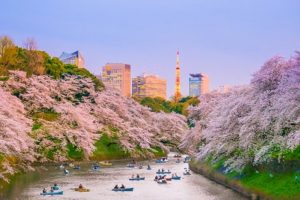
Hanami, (‘to view flowers’), is the ancient Japanese tradition of travelling to enjoy the blooming of the cherry blossom. The tradition began in the 8th century with people visiting the plum blossom. However, in the 9th century people focussed on the cherry blossom as the Emperor Saga had grand parties to celebrate them.
The cherry blossom festival lasts about 2 weeks and in the southern part of Japan where the climate is milder the trees blossom first, then those in the north blossom later. No one ever knows exactly which day the blossoms will appear, so everyone follows forecasts and predictions in anticipation, which adds to the excitement.
Hanami is a time for everyone to reflect on the fact that although the blossoms are beautiful, they do not last long. So, everyone should make the most of every moment – a notion they can apply throughout their lives.
Where to see the cherry blossom
In Tokyo, where our photo was taken, you can stroll through Ueno Park or rent a boat on the lake in Shinjuko Gyoen to see the stunning trees. However, the cherry blossom festival is not limited to Tokyo and takes place all over Japan.
Some of the best places to see the blossom are:
- Fuji Five Lakes at the northern base of Mount Fuji in Yamanashi
- Hirosaki Castle Park, Maruyama Park in Kyoto
- Mount Yoshino (Nara)
- Ueno Park in Tokyo
You can stay in the parks well into the evenings too, as most of them are lit by paper lanterns and you’ll get a different perspective of the beautiful cherry blossom.
Food and drink
Most people have picnics with friends and family under the trees and some even reserve their spots a day in advance! Shops are filled with pink treats such as pink sticky rice balls, cherry blossom cookies and pink sakura mochi (sweet rice cakes filled with red bean paste). Although most people will drink sake, tea ceremonies also take place to coincide with the festival. In more popular tourists spots you’ll be able to buy tasty treats from street food vendors too!
May
White Nights Festival, St. Petersburg, Russia
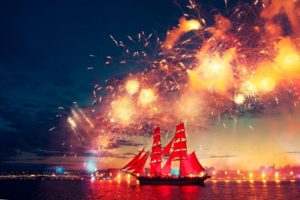
This festival celebrates ‘White nights’ or Beliye Nochi in Russian; a natural phenomenon when the sun never fully sets from May to July. People arrive from all over the world to see a collection of cultural events such as ballet and opera performances, which take place in St Petersburg throughout this period. Perhaps one of the most famous events of the festival is the ‘Scarlett Sails’.
You can see a picture of this in our calendar and find more information about the events that take place here:
Scarlett Sails
This takes place at the end of June and celebrates the end of the school year. The celebrations start with a music concert in the Palace Square before everyone flocks to the river embankment.
A boat with illuminated red sails then travels along the Neva river and a spectacular water and firework show lights up the sky. The event is traditionally for high school graduates, but it attracts a large number of visitors from around the world. 1.4 million people attended in 2019.
Stars of the white nights
Throughout the festival, you can see opera, music and ballet performances at the famous Mariinsky Theatre. This series of performances is known as the ‘Stars of the white nights’ festival and some of the shows star the famous conductor Valery Gergiev. Tickets for these performances sell out well in advance, so make sure to book early!
White Nights Marathon
For those of you who enjoy a more active pursuit, you might like to sign up to the White Nights Marathon. This is a 26-mile race through the streets of St. Petersburg where you can take in the beautiful sights and landmarks of the city. The event celebrated its 30th anniversary in 2019 and generally takes place in June or July.
June
Bali Arts Festival, (PKB), Indonesia
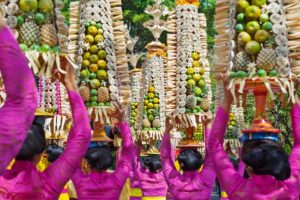
Bali Arts Festival (Pesta Kesenian Bali) is a month-long cultural festival that takes place in the island’s capital, Denpasar. The festival, which is now in its 42nd year, starts on the second Saturday in June and is one of the biggest celebrations in Bali’s calendar. Every day, people from all over the country bring to life over 300 traditional events from theatre and dance to painting and culinary experiences. It’s open to the public and is all completely free!
Here are some of the festival highlights:
The festival always begins with a carnival-style parade, which passes by the Bajra Sandhi monument. Everyone wears brightly coloured, traditional costumes from Bali and other islands in Indonesia.
After the parade, a huge opening ceremony is held at the stunning Bali Arts Centre, also known as Taman Budaya. The Arts Centre is made up of a giant amphitheatre that can seat up to 6,000 spectators, which is where the opening ceremony takes place, and other smaller stages.
Each year has a theme and the theme in 2019 was ‘Bayu Pramana’ which translates as ‘Strength of Wind’ or ‘The Breath of Life’. The theme is brought to life each year in the form of cultural performances and is reflected in displays of hand-crafted art. Also displayed are the Batuan paintings, a Balinese artistic style which originated in the Batuan village. These paintings are characterised by dark, sombre tones, lots of different shapes and images of mythical or spiritual beings.
The 4-week festival typically ends with traditional ballet dance called sendratari, which is performed on the Ardha Candra stage.
July
Bastille Day, Paris, France
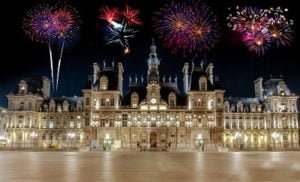
Bastille day or Fête nationale celebrates the storming of the Bastille in Paris, which took place in 1798. It is said to have been a significant turning point in the French Revolution. The Bastille prison was a symbol of the French monarchy’s authority and was stormed by revolters in an attempt to release inmates and seize ammunition stored there. Every year on 14th July, firework displays in villages, towns and cities across France light up the sky to celebrate this monumental event in history. You can see a picture of the incredible fireworks in our calendar.
Here are some of the celebrations:
Firework displays
One of the main ways in which Bastille Day is celebrated is fireworks displays and, if you find yourself in Paris, you can watch a spectacular display at 11pm in front of the Eiffel Tower.
Firemen’s balls
Perhaps one of the more unique traditions, the firemen’s balls or Bals des Pompiers take place in various fire stations around Paris. Live bands and flowing drink make for a lively atmosphere and the dancing and celebrations usually continue well into the early hours of the morning.
The fire fighters host their guests in full uniform and people in each arrondissement in Paris queue to join in with the celebrations. One of the biggest and most popular balls takes place in Sévigné firehouse. This used to be a large mansion and is the oldest fire station in Paris.
These balls take place on the night of 13th or 14th July.
Military Parade
The military parade, or Fête de la Féderation, kicks off the celebrations on the morning of 14th July. In Paris, the French army start at the Arc de Triomphe and march down the Champs-Elysées with their horses and military vehicles to mark the arrival of the French president. The military planes fly above the parade displaying the Tricolore flag; a symbol of the French revolution.
August
Notting Hill Carnival, London
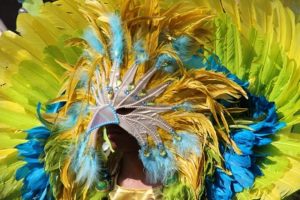
One of the largest street festivals in Europe, this vibrant celebration of Caribbean culture first started in 1966 in St. Pancras Hall. The festival was created by Trinidadian political activist, Claudia Jones in an effort to appease tensions between British residents and the Caribbean community living in London after the war. Many people came from the Caribbean to live in the UK during the 1950s as the war had badly affected the economies of the Caribbean countries.
The festival grew from a small, indoor event to the famous spectacle that it is today. People come from across London and the rest of the world to celebrate in colourful costumes and to parade through the streets of West London. It takes place every August and the dates for 2020 are Sunday 30th August – Monday 31st August.
Some of the highlights of the carnival
One of the stand-out features of the carnival is the music as performers with steel drums take part in the parade to play traditional Caribbean music such as Reggae and Calypso. Calypso is a music style that originated in the mid-90s in Trinidad and Tobago and Reggae music originated in Jamaica. You will also see Brazilian bands playing samba music, a nod to the Brazilian influences in the festival.
The food is another unmissable part of Notting Hill as food stalls line the streets to offer the delicious highlights of Caribbean cuisine. Goat curry, jerk chicken and rum punch are just a few of the tasty delights that you can sample from the 300 food stalls during the carnival.
Mas bands, or masquerade bands, parade through the streets in extravagant and colourful costumes. Each band has their own style of costume and they dance through the streets on large floats, this is called ‘playing mas’.
September
Thimphu Tshechu festival – Mongar, Bhutan
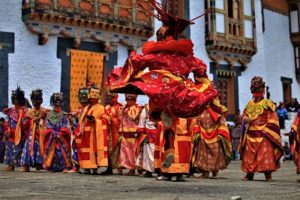
Thimphu Tshechu festival falls on the 10th day of the Tibetan lunar calendar, which is 26th September in 2020, and is the biggest and most popular festival in Bhutan. The religious festival lasts 3 days in the capital city of Thimphu. It is a celebration in honour of Guru Rimpoche, who introduced Tantric Buddhism to the Himalayas. The festival brings together people from all over Bhutan and brings them good luck and dispels misfortune.
Traditions of Thimphu Tshechu
In the days leading up to the 10th day (Tshechu means tenth day in Dzongkha), prayers and rituals are done to summon the gods.
Everyone in attendance wears traditional outfits, gho robes for men or kira dresses for women, and their finest jewellery. As a tourist, just looking at the magnificent outfits of the locals is part of the experience.
Spectators gather outside Tashichho Dzong (Buddhist monastery and fortress) to watch the traditional Cham dances (ritual dances) performed mainly by monks dressed in colourful costumes and some wearing amazing masks. These dances include:
- Shaw Shachi (Dance of the stag and hunter)
The story of hunter Gonpo Dorji who is in pursuit of a deer - Drametsi Nga Cham (Dance of the Drametsi drummers)
Each of the 100 dancers wears an animal mask and carries a drum - Guru Tshengye (eight manifestations of Guru Rinpoche)
The story of the life of Guru Rinpoche
After the dances, shop owners set up stalls in the streets and sell their stock at reduced prices. You can take away some bargains and try some tasty food!
On the last day of the festival a Thongdrel (large appliqué religious image) of Guru Rinpoche is unfolded and brings blessings to all who see it.
While you’re in Bhutan…
There are plenty of tours to go on! From trips to monasteries and temples to treks around Dagala Thousand Lakes or up to see the stunning views of Jomolhari Mountain in the Himalayas; there is something for everyone. We also highly recommend watching the sunset from the Changangkha Lhakhang shrine. It is the oldest place of worship just outside the city and sits on the top of a hill.
October
Albuquerque International Balloon Fiesta – USA

The Albuquerque International Balloon Fiesta began in 1972 and is held every year in October. It’s the largest hot air balloon event in the world and takes place in Balloon Fiesta Park in northern Albuquerque over nine days. In 2020 it’s the 3rd to 11th October.
Around 750,000 spectators flock to see over 500 balloons floating over Rio Grande Valley at this incredible event. You’ll see balloons in all shapes and sizes with everything from traditional inverted tear drops to cartoon characters, animals and famous figures like US presidents.
What happens every year
It’s an early start for everyone! The park opens around 4.30am and the event starts with the Dawn Patrol Show at 6am. During Dawn Patrol a few balloons take off to check the weather conditions for the day as music plays in the background.
Spectators can walk through the field of balloons as they inflate each morning. They can then witness the Morning Glow, which is when the inflated balloons are lit on the ground before sunrise.
The Mass Ascension event that takes place every day is the most famous and iconic of the events. Hundreds of balloons set off and fill the skies.
America’s Challenge Gas Balloon Race is also a must-see. People compete to see who can get their balloon the furthest and spectators can track competitors on an app.
Every evening, the balloons are lit again for the Evening Balloon Glows and then some of the evenings end in a huge firework display!
While you’re there…
Spectators can also head to the Balloon Discovery Center to learn about the art of ballooning and the history of the festival. There’s also a Music Fiesta, which takes place on Saturday 10th October in 2020, which spectators need to purchase a separate ticket for.
You won’t be able to resist putting this festival on your bucket list after watching this time-lapse video.
November
Día de Muertos – Mexico
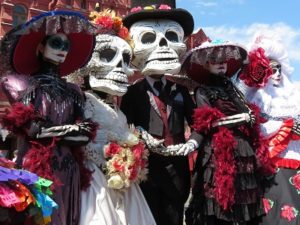
Día de Muertos is a festival celebrated in central and southern Mexico to remember and honour deceased loved ones. Known in English as Day of the Dead, this iconic festival is recognised by UNESCO for its cultural heritage. It takes place each year between the 31st October and the 2nd November.
Tradition dictates that the gates of heaven open at midnight on the 31st October. Then the spirits of children join their families on the 1st November (All Saints’ Day) and the spirits of adults join their families on the 2nd November (All Souls’ Day).
Ofrendas
Families make ofrendas (altars) in their homes, on which they put photos of their loved ones, candles and marigolds. They then leave a trail of marigolds leading up to the altar, which people believe helps guide the spirits.
Families decorate graves too, and people go en masse to visit them during the 2-day period. They offer special food and drink to the spirits. One of the main foods offered is pan de muerto (bread of the dead), which is a sweet, brioche-like bread. You’ll also see intricately decorated calaveras de azúcar (sugar skulls), candied pumpkin and other sweets and desserts. The sweetness is a contrast to the bitterness of death. There are also Mariachi bands a plenty playing in the cemeteries as people celebrate the lives of their loved ones.
There are public celebrations all over too. People dress in costumes, paint their faces as calaveras (skulls) and sing and dance with their families and friends.
December
Christmas, Prague, Czech Republic
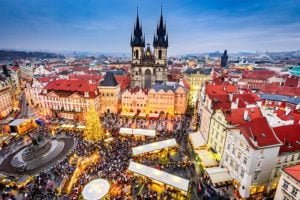
Every year, Prague hosts some of the biggest and best Christmas markets in Europe. Between December and January, this fairy-tale-like city welcomes visitors to some of its key landmarks. You can find Christmas markets in Old Town Square, Prague Castle and Wenceslas Square to name just a few.
If you’d like to do some Christmas shopping, many of the stalls sell souvenirs and decorations. You can find beautiful hand painted glass baubles and quirky wooden puppets. You can also sample some traditional Czech produce such as Modovina (honey wine) or Svarene Vino (hot, spiced wine). Another delight of these markets is Trdelnik, a circular, sugared dough, served fresh and warm with a sprinkling of cinnamon.
Aside from the food and shopping, Prague is the perfect place to visit to soak up the magical, festive atmosphere. In Old Town Square, a beautifully decorated tree stands at the heart of the markets and the decorated wooden huts reflect the theme of the markets. This year the theme is angels.
The main Christmas celebrations in the Czech Republic take place on Christmas Eve when the whole family come together for a meal. During the meal, Ježíšek or Little Jesus brings presents for the children and places them under the tree. A bell then rings and the children can open their presents.
Other things to see whilst visiting Prague
Every hour, the astronomical clock on the old town hall in Old Town Square comes alive. If you’re there at the right time, you can watch the mechanical clock perform a procession of the Twelve Apostles.
The Charles Bridge is another stunning landmark that you cannot miss! Connecting two sides of the city over the Vltava river, it’s popular with street artists and vendors throughout the year. From the bridge, you can see the spectacular Prague Castle. Not only is it a UNESCO World Heritage site, it is the largest castle complex in the world covering 70,000 m₂. The castle sits in the Hradčany area of Prague and one of the main buildings of the complex is St. Vitus Cathedral.
And that’s it for our Festivals around the World! We hope you enjoyed reading about them as much as we enjoyed writing about them.
If you’d like one of our 2020 calendars send us an email.



